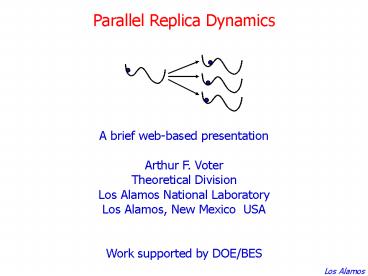PowerPoint Presentation Accelerated Molecular Dynamics Methods - PowerPoint PPT Presentation
1 / 19
Title:
PowerPoint Presentation Accelerated Molecular Dynamics Methods
Description:
Blas Uberuaga. Steve Stuart. Los Alamos. Energy vs Strain for. Nanotube with a Vacancy ... formed. second defect. formed. Blas Uberuaga. Steve Stuart. Los ... – PowerPoint PPT presentation
Number of Views:43
Avg rating:3.0/5.0
Title: PowerPoint Presentation Accelerated Molecular Dynamics Methods
1
Parallel Replica Dynamics
A brief web-based presentation Arthur F.
Voter Theoretical Division Los Alamos National
Laboratory Los Alamos, New Mexico USA Work
supported by DOE/BES
2
Parallel Replica Dynamics
The system vibrates in 3-N dimensional basin many
times before finding an escape path. Using many
trajectories in parallel, we can find a correct
escape event more quickly. (I.e., the
probability for escaping along a certain path
should be proportional to the rate constant for
that path.)
3
Parallel Replica Dynamics
- Parallelizes time evolution
- Assumptions
- - infrequent events
- - exponential distribution of first-escape times
AFV, Phys. Rev. B, 57, R13985 (1998)
4
Parallel Replica Dynamics Procedure
Replicate entire system on each of M processors.
5
Parallel Replica Dynamics Procedure
Randomize momenta independently on each processor.
6
Parallel Replica Dynamics Procedure
Run MD for short time (tdephase) to dephase the
replicas.
7
Parallel Replica Dynamics Procedure
Start clock and run thermostatted MD on each
processor. Watch for transition
8
Parallel Replica Dynamics Procedure
Stop all trajectories when first transition
occurs on any processor.
9
Parallel Replica Dynamics Procedure
Sum the trajectory times over all M processors.
Advance simulation clock by this tsum
10
Parallel Replica Dynamics Procedure
On the processor where a transition occurred,
continue trajectory for a time tcorr to allow
correlated dynamical events.
11
Parallel Replica Dynamics Procedure
Advance simulation clock by tcorr.
12
Parallel Replica Dynamics Procedure
Replicate the new state and begin procedure again.
13
Parallel Replica Dynamics
The summed time (tsum) obeys the correct
exponential distribution, and the system escapes
to an appropriate state. State-to-state dynamics
are thus correct tcorr stage even releases the
TST assumption AFV, Phys. Rev. B, 57, R13985
(1998). Good parallel efficiency if trxn / M
gtgt tdephasetcorr Applicable to any system with
exponential first-event statistics
14
Detecting a transition
- best method depends on the system -
simple method for EAM metal systems
periodically perform steepest-descent quench
see if geometry at basin minimum has changed
- other methods - change in bond
connectivity (Kum, Uberuaga) - change in local
order parameter - change in energy fluctuations
(Pande)
15
Parallel-replica dynamics example
Ag(111) island-on-island decay Embedded atom
(EAM) potential Temperature 400K 5 days on 32
processors (1 GHz Pentium-IIIs) Upper island
decays into lower island via step-edge exchange
events. For this case, parallel replica is even
faster than temperature-accelerated dynamics,
since barriers are low relative to T. F.
Montalenti, T.C. Germann and A.F. Voter
16
Parallel replica dynamics for driven systems
Example Stretching a nanotube on ten
processors On each of the 10 processors,
strain rate 107 s-1 Effective system strain
rate 106 s-1 State-to-state evolution is
valid provided the driving rate on each processor
is slow enough that the escape rates at any
instant in time are independent of the driving
rate. (Uberuaga, Stuart and Voter, to be
published). Notes 1) during correlated-event
time, use the lower (global) driving rate 2)
processors must run at same speed (unnecessary
for regular parallel-replica)
17
Stretching Nanotubes
- Parallel replica dynamics on 40 processors (1
GHz Pentium IIIs) - REBO potential Brenner et
al, J. Phys. Condensed Matter 14, 783 (2002) -
T2000K - One pre-existing vacancy
unstretched
slow strain rate
fast strain rate
.
.
e106/s yielded at 15
e5x108/s yielded at 24
Blas Uberuaga Steve Stuart
18
Final Structure of Nanotubes after Yield
Lower strain rate (106/s)
Higher strain rate (5x108/s)
5-7 defect
Blas Uberuaga Steve Stuart
19
Energy vs Strain for Nanotube with a Vacancy
second defect formed
5-7 defect formed
Blas Uberuaga Steve Stuart
20
- THE END































